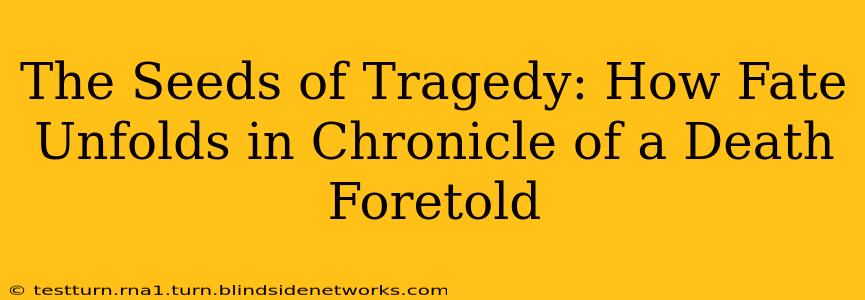Gabriel García Márquez’s Chronicle of a Death Foretold isn't just a story; it's a chilling exploration of fate, responsibility, and the suffocating weight of societal expectations. It’s a tapestry woven with threads of prophecy, machismo, and the inescapable consequences of inaction, leaving the reader breathlessly suspended between the inevitability of Santiago Nasar's murder and the haunting question: could it have been prevented?
The novel unfolds not as a linear narrative, but as a fragmented reconstruction of the events leading up to Santiago's death. This fragmented structure, mirroring the fractured memories and collective guilt of the town, immediately throws the reader into the heart of the mystery, forcing us to piece together the puzzle alongside the narrator. We are privy to whispers, rumors, and conflicting accounts, mirroring the hazy reality of a town gripped by a foretold tragedy.
What is the central theme of Chronicle of a Death Foretold?
The central theme revolves around the inescapable nature of fate intertwined with the profound responsibility of individuals and society. While the prophecy of Santiago's murder hangs heavy over the narrative, the novel powerfully demonstrates how the collective inaction of the town, fueled by fear, pride, and social customs, ultimately seals his doom. It's not just about fate; it's about the choices—or lack thereof—that shape destiny.
What is the significance of the title Chronicle of a Death Foretold?
The title itself is a powerful statement. "Chronicle" suggests a meticulous recording of events, a painstaking reconstruction of the past. "Death Foretold" underscores the premonition hanging over Santiago's life, highlighting the chilling awareness of his impending demise. The juxtaposition of these two elements forces us to confront the unsettling idea that even with foreknowledge, tragedy can still unfold. The narrative becomes a stark reminder that knowing the future doesn't necessarily equate to the power to change it.
How does the setting influence the events of the novel?
The setting—a small, isolated town steeped in tradition and patriarchal values—plays a crucial role. The suffocating atmosphere of the town, governed by unspoken rules and rigid social hierarchies, inhibits action and breeds a culture of fatalistic acceptance. The town's collective silence, born from fear and a desire to maintain the status quo, directly contributes to the tragedy. The very structure of the society, with its ingrained machismo and honor culture, becomes a breeding ground for violence.
What is the role of honor in the novel?
The concept of "honor" is profoundly distorted in the novel. It fuels the brothers’ actions, blinding them to the consequences of their violent revenge. Their warped sense of honor, dictated by societal expectations, overrides any sense of justice or morality. The town's passive acceptance of this skewed notion of honor underscores the destructive power of social norms that prioritize violence over reconciliation.
How does the narrative structure contribute to the overall meaning?
The non-linear narrative structure is crucial to the novel's impact. Instead of a chronological recounting, Márquez uses flashbacks, shifting perspectives, and fragmented recollections to mimic the town's collective memory of the event. This fragmented approach emphasizes the ambiguity surrounding Santiago's death, highlighting the multiplicity of perspectives and the difficulty of assigning clear-cut blame. It forces the reader to actively participate in the reconstruction of the narrative, mirroring the town's own grappling with the tragedy.
What is the significance of the recurring imagery and symbolism?
The novel is rich in symbolism and recurring imagery. The recurring motif of birds, for instance, symbolizes the inevitability of fate and the helplessness of those caught in its web. The vivid descriptions of the town, its people, and its customs serve to create a claustrophobic atmosphere, intensifying the sense of impending doom. The repeated references to specific details – the precise time of day, the color of Santiago’s clothing – underscore the methodical nature of the plan and the chilling precision of its execution.
In conclusion, Chronicle of a Death Foretold is more than just a murder mystery; it is a powerful meditation on fate, free will, and the devastating consequences of societal indifference. Márquez masterfully weaves a tapestry of fragmented memories, symbolic imagery, and social commentary, leaving the reader haunted by the tragedy and pondering the chilling question of how far we are willing to go to avoid confronting our own complicity in the unfolding of fate.

